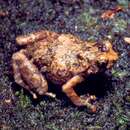Description
provided by AmphibiaWeb articles
M 21-24 mm. Tympanum distinct, 3/5 of eye diameter. Tibiotarsal articulation reaches the tympanum. Toe 3 longer than toe 5. Skin smooth or slightly granular. Dorsally variable, brown with symmetrical dark and light markings. Ventrally uniform grey with a dark throat (Glaw and Vences 2007).Similar species: A. boulengeri (Glaw and Vences 2007).Taken with permission from Glaw and Vences (2007) and Nussbaum and Vallan (2008).
Nussbaum, R. and Vallan, D. (2008). Anodonthyla nigrigularis. In: IUCN 2008. 2008 IUCN Red List of Threatened Species. www.iucnredlist.org. Downloaded on 01 May 2009.
- author
- Miguel Vences
- author
- Frank Glaw
Distribution and Habitat
provided by AmphibiaWeb articles
Species is located in Andohahela, Malahelo, Nahampoana, Tolagnaro (Glaw and Vences 2007). It ranges from sea level to 1500m asl (Nussbaum and Vallan 2008).
- author
- Miguel Vences
- author
- Frank Glaw
Life History, Abundance, Activity, and Special Behaviors
provided by AmphibiaWeb articles
Habits: Calls from tree trunks or rocks at perch heights of 1 m. Eggs and tadpoles in water-filled tree holes, guarded by the male (Glaw and Vences 2007).Calls: A single short melodious note that is repeated after regular intervals. Note repetition rate 85/min (Glaw and Vences 2007).
- author
- Miguel Vences
- author
- Frank Glaw
Life History, Abundance, Activity, and Special Behaviors
provided by AmphibiaWeb articles
Species is listed as data deficient because of continuing uncertainties as to its extent of occurrence, status and ecological requirements. Its forest habitat is receding due to subsistence agriculture, timber extraction, charcoal manufacture, invasive spread of eucalyptus, livestock grazing, fires and expanding human settlements. It occurs in the R�serve Sp�ciale d�Ambohitantely, which is poorly managed, and Parc National d'Andohahela, which is well managed (Nussbaum and Vallan 2008).
- author
- Miguel Vences
- author
- Frank Glaw

